Related Research Articles

The cotton-top tamarin is a small New World monkey weighing less than 0.5 kg (1.1 lb). This New World monkey can live up to 24 years, but most of them die by 13 years. One of the smallest primates, the cotton-top tamarin is easily recognized by the long, white sagittal crest extending from its forehead to its shoulders. The species is found in tropical forest edges and secondary forests in northwestern Colombia, where it is arboreal and diurnal. Its diet includes insects and plant exudates, and it is an important seed disperser in the tropical ecosystem.

The kipunji, also known as the highland mangabey, is a species of Old World monkey that lives in the highland forests of Tanzania. The kipunji has a unique call, described as a 'honk-bark', which distinguishes it from its relatives, the grey-cheeked mangabey and the black crested mangabey, whose calls are described as 'whoop-gobbles'.

Barbara Brown's titi monkey, also popularly known as the blond titi monkey or northern Bahian blond titi, is a species of titi, a type of New World monkey. This critically endangered species is endemic to the Caatinga in northeastern Brazil, and it is estimated that less than 250 mature individuals remain. It is named after the zoologist Barbara Elaine Russell Brown.

The brown spider monkey or variegated spider monkey is a critically endangered species of spider monkey, a type of New World monkey, from forests in northern Colombia and northwestern Venezuela.
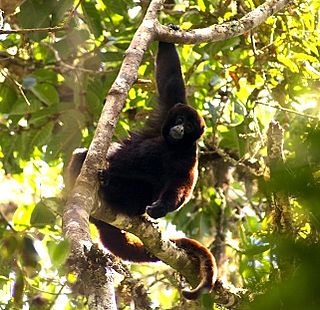
The yellow-tailed woolly monkey is a New World monkey endemic to Peru. It is a rare primate species found only in the Peruvian Andes, in the departments of Amazonas and San Martin, as well as bordering areas of La Libertad, Huánuco, and Loreto.

The greater bamboo lemur, also known as the broad-nosed bamboo lemur and the broad-nosed gentle lemur, is a species of lemur endemic to the island of Madagascar.
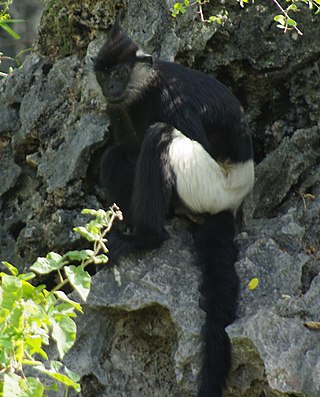
Delacour's langur or Delacour's lutung is a critically endangered species of Old World monkey endemic to northern Vietnam. It is named for French-American ornithologist Jean Théodore Delacour.

The Cat Ba langur, also known as the golden-headed langur, is a critically endangered species of langur endemic to Cát Bà Island, Vietnam. It is among the rarest primates in the world, and possibly the rarest primate in Asia, with population size estimated at less than 70 individuals.

The Rondo dwarf galago or Rondo bushbaby is a species of primate in the family Galagidae. The dwarf galagos are the smallest members of the genus Galagoides. It weighs less than 100 grams, making it the smallest known galago. It is endemic to Tanzania where its natural habitat is subtropical or tropical dry forests. It lives in an area reported in 2012 to be less than 100 square kilometers and is threatened by habitat loss due to logging. While it was discovered in the 1950s, the Rondo dwarf galago was deemed data deficient until 1996. In 1996, the Rondo dwarf galago was fully described as a species. It is now listed as one of "The World's 25 Most Endangered Primates."

The Javan slow loris is a strepsirrhine primate and a species of slow loris native to the western and central portions of the island of Java, in Indonesia. Although originally described as a separate species, it was considered a subspecies of the Sunda slow loris (N. coucang) for many years, until reassessments of its morphology and genetics in the 2000s resulted in its promotion to full species status. It is most closely related to the Sunda slow loris and the Bengal slow loris (N. bengalensis). The species has two forms, based on hair length and, to a lesser extent, coloration.
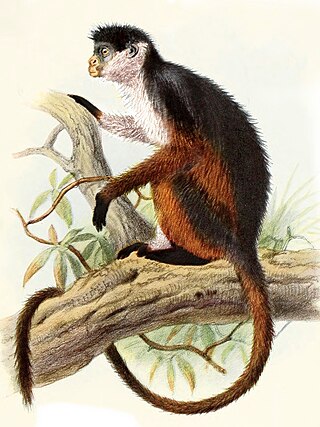
Pennant's colobus or Pennant's red colobus is a species of tree-dwelling primate in the family Cercopithecidae. It is endemic to tropical Central Africa. Three subspecies have traditionally been recognised but its distribution is peculiarly disjunct and has been considered a biogeographical puzzle, with one population on the island of Bioko, a second in the Niger River Delta in southern Nigeria, and a third in east-central Republic of Congo. It is found in rainforests and marshy forests. It is threatened by habitat loss and hunting for bushmeat.
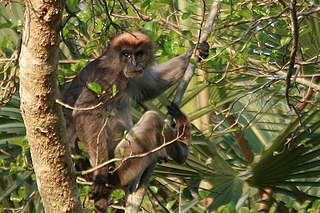
The Tana River red colobus, also called the eastern red colobus, is a highly endangered species of primate in the family Cercopithecidae. It is endemic to a narrow zone of gallery forest near the Tana River in southeastern Kenya.
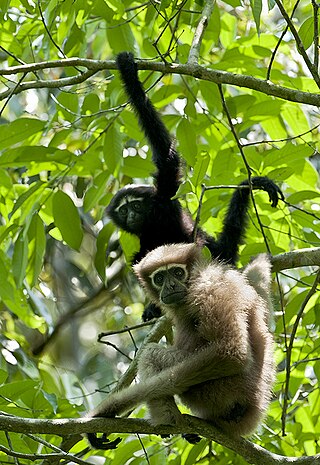
The western hoolock gibbon is a primate from the gibbon family, Hylobatidae. The species is found in Assam, Mizoram, and Meghalaya in India, Bangladesh, and Myanmar west of the Chindwin River.

The gray-headed lemur, or gray-headed brown lemur, is a medium-sized primate, a cathemeral species of lemur in the family Lemuridae. Until a taxonomic revision in 2008, it was known as the white-collared brown lemur or white-collared lemur. It lives in south-eastern Madagascar. In 2005, satellite imagery estimates showed approximately 700 km2 (270 sq mi) of total remaining habitat within its geographic range. It is highly threatened by hunting and habitat loss, and was considered to be among the 25 most endangered primates in 2006–2008. It is currently listed as Critically Endangered by the International Union for Conservation of Nature (IUCN) due to a highly restricted range, and has been named one of "The World's 25 Most Endangered Primates."

The Siau Island tarsier is a species of tarsier from the tiny volcanic island of Siau in Indonesia. The T. tumpara species is one of 14 species and 7 subspecies in the tarsier family called "Tarsiidae". They belong to the Haplorrhini suborder, known as the "dry-nosed" primates. The tarsier's eyes are so big that they do not move in its socket and they are almost as big as its brain. The name tumpara, which means tarsier in the local language of Sulawesi, was an attempt to encourage the community in preserving this biological heritage.
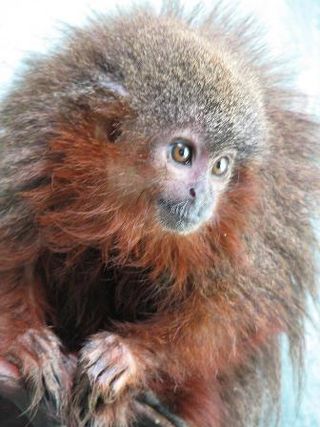
The Caquetá titi monkey, also known as the red-bearded titi or the bushy-bearded titi, is a species of titi monkey endemic to Colombia found in the Department of Caquetá region. Taxonomically, it is a member of the "Callicebus cupreus group", following Shunsuke Kobayashi's Callicebus grouping. It was first described by Thomas Defler, Marta Bueno and Javier Garcia in 2010. It is highly endangered due to habitat fragmentation and a small population.

The World's 25 Most Endangered Primates is a list of highly endangered primate species selected and published by the International Union for Conservation of Nature (IUCN) Species Survival Commission (SSC) Primate Specialist Group (PSG), the International Primatological Society (IPS), Global Wildlife Conservation (GWC), and Bristol Zoological Society (BZS). The IUCN/SSC PSG worked with Conservation International (CI) to start the list in 2000, but in 2002, during the 19th Congress of the International Primatological Society, primatologists reviewed and debated the list, resulting in the 2002–2004 revision and the endorsement of the IPS. The publication was a joint project between the three conservation organizations until the 2012–2014 list when BZS was added as a publisher. The 2018–2020 list was the first time Conservation International was not among the publishers, replaced instead by GWC. The list has been revised every two years following the biannual Congress of the IPS. Starting with the 2004–2006 report, the title changed to "Primates in Peril: The World's 25 Most Endangered Primates". That same year, the list began to provide information about each species, including their conservation status and the threats they face in the wild. The species text is written in collaboration with experts from the field, with 60 people contributing to the 2006–2008 report and 85 people contributing to the 2008–2010 report. The 2004–2006 and 2006–2008 reports were published in the IUCN/SSC PSG journal Primate Conservation,, since then they have been published as independent publications.
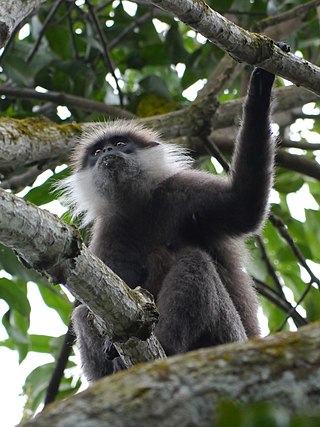
The western purple-faced langur, also known as the north lowland wetzone purple-faced langur, is a subspecies of purple-faced langur endemic to Sri Lanka. It lives in the wet zone in western Sri Lanka around the former capital city of Colombo. This subspecies are known to live in tropical rainforest, specifically in an area of Sri Lanka, where it is noted to rain two times more compared to the neighboring region. The subspecies is generally gray-brown with lighter whiskers, a gray rump patch, and dark forearms and legs. These monkeys also have dark brown or black, hairless faces. Their hands and feet are also hairless. When infants, their fur is medium brown to light gray, however it changes to their darker adult colors at between 12 and 16 weeks old. Typical length is between 48 and 67 centimetres excluding tail, with a 59 to 85 centimetres tail. On average, males weigh 8.5 kilograms (19 lb) and females weigh 7.8 kilograms (17 lb). Their average life span is about 26 years if the monkey was held in captivity. Due to their leafy diet, the western purple-faced langur back teeth, include high crowns and pointed cusps to make eating through greenery simpler. They also developed a digestive system that would allow them to break down cellulose in the leaves they eat. Although, leaves are their primary source of food, they also eat fruits and flowers. Female langurs hold a pregnancy for 195–210 days, and after the birth the offsprings are taken closely cared for by the mother until they are about 12–20 weeks old.

The Niger Delta red colobus is a critically endangered species of colobus monkey endemic to the western part of the Niger Delta. It is threatened by hunting and habitat loss.
References
- ↑ Mittermeier, R.A.; Wallis, J.; Rylands, A.B.; Ganzhorn, J.U.; Oates, J.F.; Williamson, E.A.; Palacios, E.; Heymann, E.W.; Kierulff, M.C.M.; Long Yongcheng; Supriatna, J.; Roos, C.; Walker, S.; Cortés-Ortiz, L.; Schwitzer, C., eds. (2009). Primates in Peril: The World's 25 Most Endangered Primates 2008–2010 (PDF). Illustrated by S.D. Nash. IUCN/SSC Primate Specialist Group (PSG), International Primatological Society (IPS), and Conservation International (CI). pp. 1–92. ISBN 978-1-934151-34-1. Archived from the original (PDF) on 2011-08-10.
- ↑ "Jan van Hooff" (in Dutch). Utrechtse Biologen Vereniging. Archived from the original on 7 February 2023.